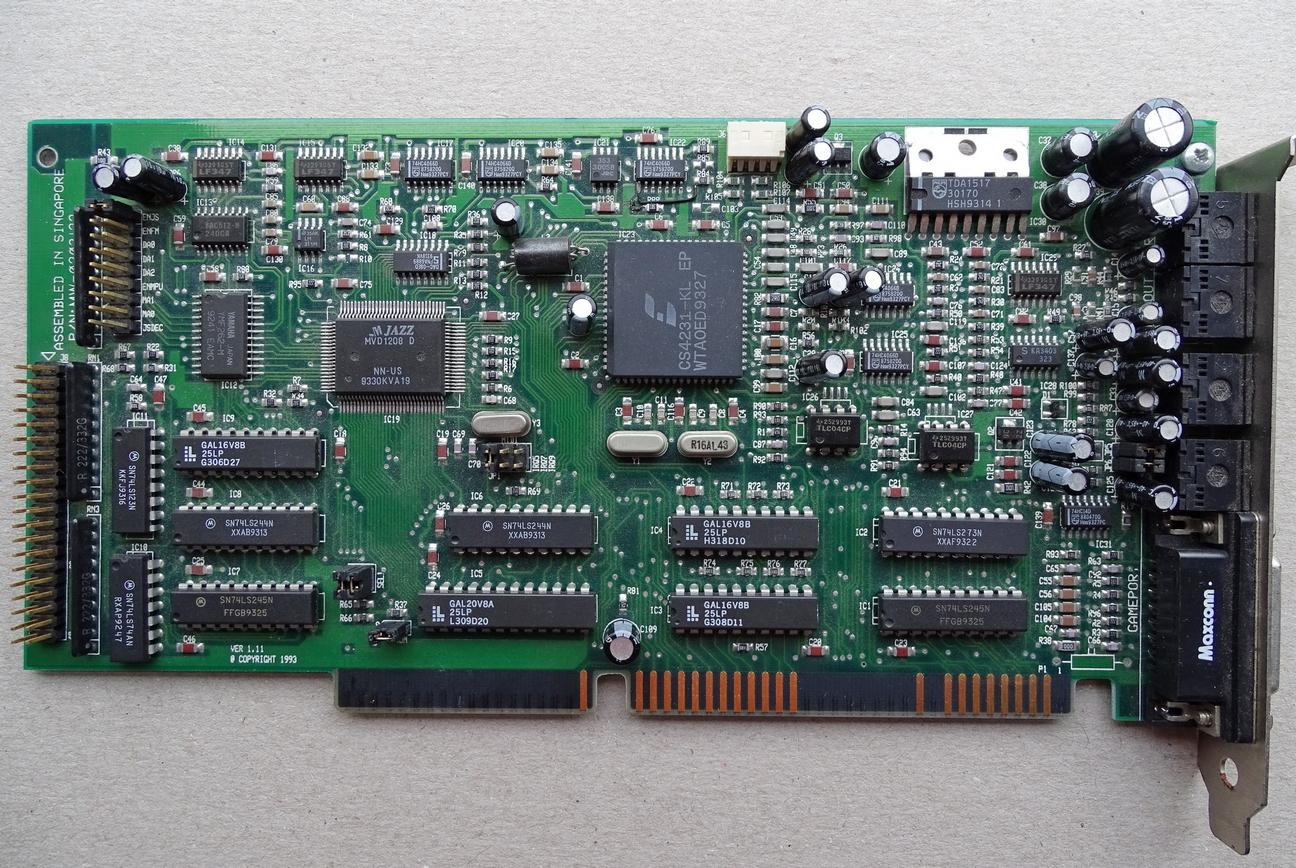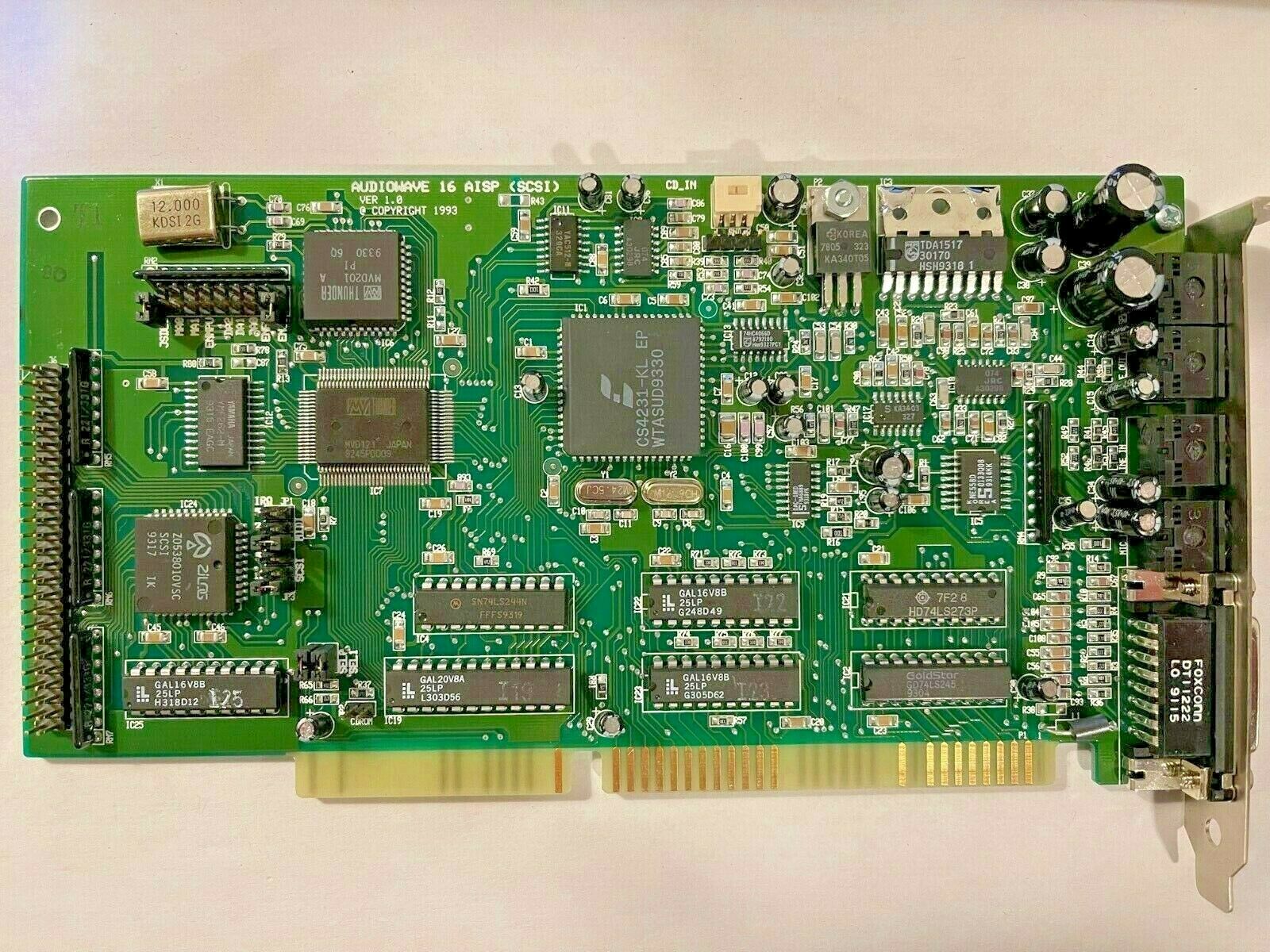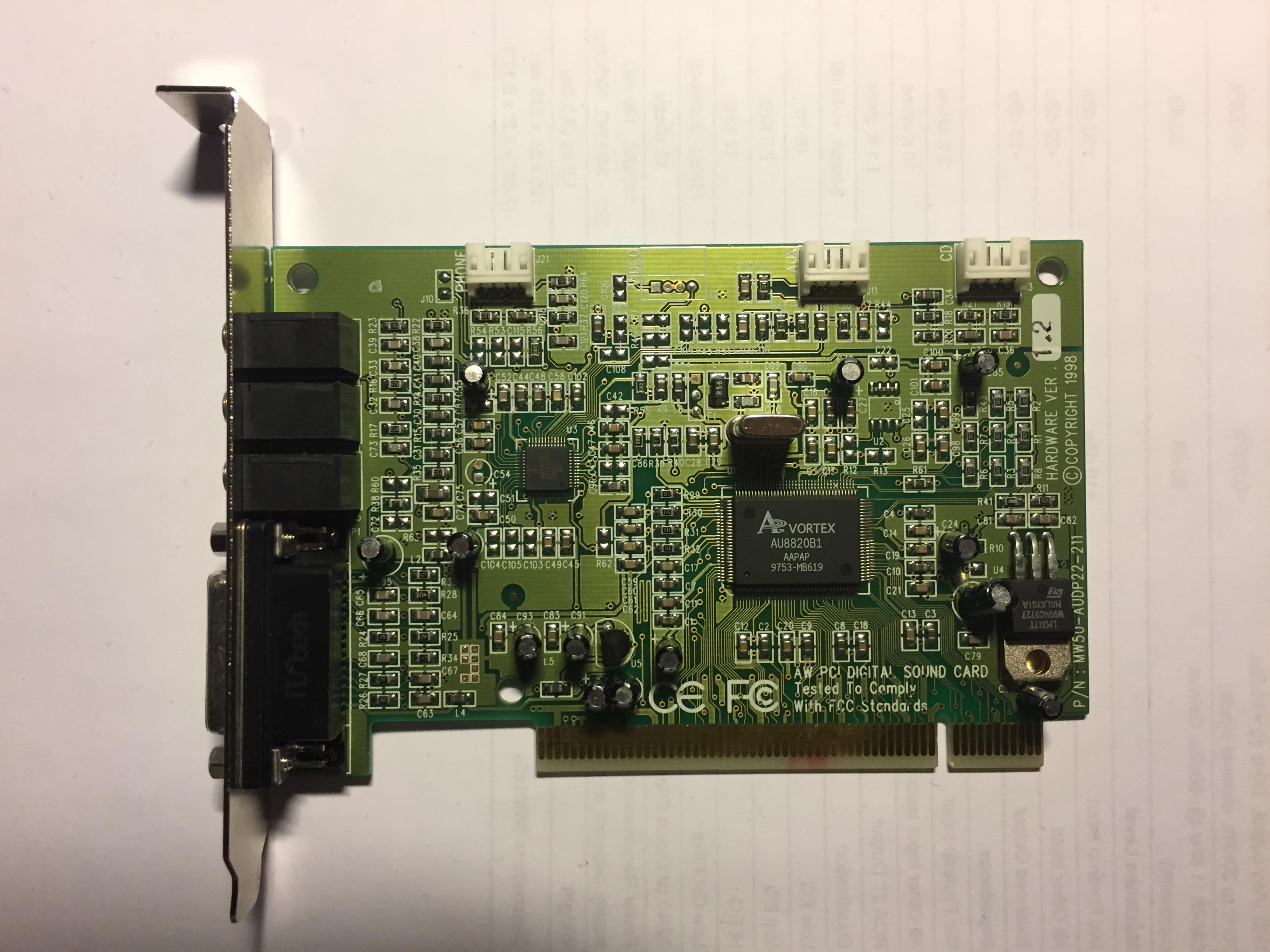Multiwave Innovation were a Singapore-based producer of audio and communications products for the PC during the 1990s. The company was started in 1988 as a manufacturer of modem products before expanding into sound and video cards, and later multimedia. Their product range comprised AudioWave, CommWave and MovieWave devices.
They entered into a tie-in with Uraco Holdings, a disk drive component manufacturer, and NatSteel Electronics, which would help them capitalise on the growing multimedia market.
.jpg) AudioWave 16 AISP (SCSI) AudioWave 16 AISP (SCSI)     
Launched: 1993
Chipset: Crystal CS4231KL, MediaVision Thunder Board, Yamaha YMF262
Bus: ISA 16-bit
Plug & Play: No
Wave Blaster header: No
The AudioWave 16 AISP (SCSI) and AudioWave 16 AISP Pro were some of the first (if not 'the' first) sound cards produced by MultiWave Innovations. With a broad amount of technology built onto these sound cards, they both supported Ad Lib, Sound Blaster, Media Vision Thunder Board, Sound Blaster Pro, and Windows Sound System.
 The SCSI variant of course also came with a SCSI CD-ROM interface and controller circuitry. The SCSI variant of course also came with a SCSI CD-ROM interface and controller circuitry.
There is almost no information online about these cards, and I don't even know what the 'Pro' came with that the non-Pro variant lacked. They might be the same card and perhaps the Pro just came bundled with more software?
I have the AISP (SCSI) version, and did a retro review of it in November 2023.
More Images
.jpg) .jpg)
|
 AudioWave Platinum 16 AudioWave Platinum 16       
Launched: 1993
Chipset: Crystal CS4231KL, MediaVision Jazz, Yamaha YMF262
Bus: ISA 16-bit
Plug & Play: Yes
Wave Blaster header: Yes
The Platinum 16 was a 16-bit ISA sound card that supported Ad Lib, Sound Blaster, Sound Blaster Pro and Windows Sound System. It was based on the MediaVision Jazz 8 chipset coupled with the Crystal CS4231.
The Platinum 16 was sold separately, but was also bundled in what MultiWave called the AWS32. This package comprised the Platinum 16 card, their DreamWave wavetable daughterboard (based on the Dream SAM9203), and their 3D Space daughterboard which provided 3D effects from a stereo sound source.
"The MultiWave Innovation AudioWave Platinum 16 board is a general-purpose sound card suitable for games, business applications, and desktop presentations. This FM synthesis board offers above-average sound quality with a broad upgrade path: Wavetable MIDI, three-dimensional sound, and a SCSI CD-ROM interface are all options. The board lists for $299; discounted, it sells for about $229.
The AudioWave Platinum 16 evidenced extremely
low distortion and yielded an impressively high signal-to-noise ratio on most of our objective tests. Its preamplifier was nearly the equal of the Turtle Beach MultiSound, except for its poor treble frequency response. Also, we noticed some minor clicking during playback of CD audio in our subjective testing.
A videotape is included with the package in order to guide you through the installation procedure, but setting up the board turned out to be easy and uneventful.
Everything worked for us on the first try.
Bundled with the board is Voyetra's Multimedia Toolkit, including Audio Station (a rack-mounted interface to .WAV, MIDI, CD audio, line-in, and mixer modules). Other bundled utilities include Say It (for annotating Windows documents with sound) and First Byte's Monologue for Windows.
The AudioWave Platinum 16
is based on a Yamaha OPL-3 sound chip; it is compatible with both the Creative Labs Sound Blaster standard and the Microsoft Windows Sound System. The board includes a connector for a $199 wavetable synthesizer upgrade ("Wave FX" module). The board's DSP can also be used to provide a three-dimensional effect via Multiwave's 3D Space module ($79).
The Multiwave
AudioWave Platinum 16's built-in CD-ROM interface supports Mitsumi, Panasonic, and Sony drives, and you can add SCSI CD-ROM support via a $29 daughtercard. " PC Magazine, 12th April 1994
|
 AudioWave Green 16 AudioWave Green 16   
Launched: 1994
Chipset: ESS ES688
Bus: ISA 16-bit
Plug & Play: No
Price When New: $99
The AudioWave Green 16 was a generic card based on the ESS Technologies ES688 chip. This did not come with the ESFM OPL3-compatible audio capability.
"If all you need from a sound board are the bare essentials, consider the $79 ACS LaserWave Nucleus 16 from ACS/KRIS Technologies. This low-priced FM-synthesis sound board is acceptable for voice annotation and playing CD-ROM titles where high fidelity will not be missed. This same board is distributed by Multiwave Innovation as the Multiwave Audiowave Green 16 ($99 list, $89 street), which includes headphones and a microphone. We tested the Green 16 with its DreamWave wavetable daughterboard (a $79 option from Multiwave, $99 from ACS), but we were disappointed with the sound quality.
Both boards were relatively easy to install, with a Windows-based installation program that identifies IRQ
and memory address conflicts with your existing hardware and recommends alternatives. The inputs and outputs on the boards' backplanes are not labeled, which means you'll have to consult the manual each time you want to connect speakers or a microphone. The boards provide proprietary interfaces for Mitsumi, Panasonic, and Sony CD-ROM drives, as well as an optional SCSI daughterboard (about $25). The ESS 688F chip in both boards shuts off the power when the board is not in use. The boards are Microsoft Windows Sound System-compatible but lack full Sound Blaster functionality. You can initialize the card in DOS, but the executables do not provide the information a game (such as DOOM) needs to utilize the cards' services.
Software audio controls are rudimentary: The mixer allows only volume control and muting capabilities. There is a separate mixer control for recording, but it does not give the user enough control for multimedia authoring work. The software's most useful feature is a library of audio clips that are ideal for adding splashes of sound to business documents. The Green 16 also comes with applets to play MIDI files, .WAV files, and audio CDs.
The ACS LaserWave and the Green 16 turned in unacceptable marks on most of our tests. Digital playback frequency response was poor, as the units dropped sounds in both the low and high ends of the audio spectrum. THD+N also exceeded our 0.1 threshold, and the boards
were among the worst performers on our Digital Recording tests. Digital playback was highly distorted and lacking in both bass and treble. Our 8-bit and 16-bit .WAV files produced fair sound, acceptable for voice applications; FM-synthesis MIDI files sounded artificial and produced an unacceptable amount of noise.
The meager FM synthesis of the Yamaha OPL3 can be replaced by adding a Wave Blaster-compatible upgrade card (with the Green 16, we used Multiwave's DreamWave with the Crystal Dream wavetable synthesizer). Although the DreamWave was certainly a step up from FM synthesis MIDI, its music is unimpressive compared with other wavetable cards. With only 24-note polyphony and 20-voice multitimbrality, this card is not appropriate for MIDI composers." PC Magazine
|
AudioWave 16PNP       
Launched: August 1995
Chipset: ESS ES1688
Bus: ISA 16-bit
Plug & Play: Yes
The AudioWave 16PNP was a sound card based on the ES1688 audio codec chip from ESS Technologies. It had these core features:
- True Single Chip (ES1688) 16-bit Sound Board - a complete 16-bit stereo audio and OPL3 compatible FM Music Synthesis solution in one single chip. Supports 8-bit/16-bit audio stereo/mono recording & playback from 4 Khz to 44.1 Khz, multiple audio sources recording and 16-bit dynamic range ideal for advanced voice recognition.
- Full Plug-N-Play and Windows 95 ready - Supports Intel’s Plug-N-Play specifications and Windows 95 to make installation trouble free.
- IDE interface for Double & Quad Speed CD-ROM drives
- 20-Voice, 72 operator, OPL3 compatible ESFM Music Synthesizer
- MIDI and Joystick interface - Built-in MPU401 (SMART & UART mode) and SB MIDI interface for any MIDI devices
- Built-in selectable 6V or 9V DC supply for any external active speakers - the only sound card with a selectable 6V or 9V DC output to power external active speakers. 4-watt per channel Class B stereo amplifier with typically 0.1% distortion.
- Upgradable with a Wave-Table Synthesizer
Note that to run DOS games you may need to run the MPNP.EXE utility to get sound to work.
There was also the AudioWave 16PNP FD which was a full duplex version of the AudioWave 16PNP based on the more advanced ES1868 audio codec chip.
"Multiwave Innovation Releases AudioWave 16 Plug and Play Full Duplex
Full Duplex 16-bit Sound Card Ready for Internet Phone Applications
San Ramon (California), March 14, 1996 -- Multiwave Innovation introduces the latest member to its family of distinguished sound cards. The 16 plug and play full duplex sound card boasts of a true single 16-bit high quality stereo ESS1868 sound chip. This makes the sound card a complete high-performance, mixed-signal, 16-bit and FM Music Synthesis solution in one single chip. Besides it has full duplex support for Internet PhoneTM , CyberPhoneTM , VDO Phone.
"AudioWave 16 Plug and Play Full Duplex represents a standard that will benefit the industry and our customers," stated Mr. James Tan, Multiwave Innovation President. "The ESS1868 chipset makes it a more robust product that delivers new levels of performance and functionality."
Supporting Intel's Plug-and-Play specifications and Windows '95 ready makes the sound card user-friendly both during installation and operation. The plug and play features enables both expert and non-expert users to install the card easily and quickly. With hassle-free installations, users can instantly enjoy the reproductions of its built-in 20-voice, 72 operator, OPL3 compatible ESFM music synthesizer.
The AW 16 PnP FD supports IDE CD-ROM drives Besides it has advanced audio features allowing 8-bit / 16-bit audio stereo / mono recording & playback from 4 kHz to 44.1 KHz. Also it permits multiple audio sources recording and 16-bit dynamic range ideal for advanced voice recognition." Multiwave press release, 14th March 1996
|
 AudioWave 32PNP AudioWave 32PNP       
Launched: November 1995
Chipset: ESS ES1688
Bus: ISA 16-bit
Plug & Play: Yes
The AudioWave 32PNP had these features:
- True Single Chip (ES1688) 16-bit Sound Board - built-in 20-Voice, 72-operator, OPL3 compatible ESFM Music Synthesizer. Supports 8-bit/16-bit audio stereo/mono recording & playback from 4 Khz to 44.1 Khz, multiple audio sources recording & 16-bit dynamic range ideal for advanced voice recognition.
- Full Plug and Play and Windows 95 ready.
- Built-in 32-voice Wave-table synthesizer includes 51 drum sets - using 1 Mbyte ROM for General MIDI (GM) sound library of 128 standard instrument sets and 47 Drum Sets, and together with an integrated single chip General MIDI Intepreter, a high quality 32-voice, 44.1KHz realistic sound is generated under any DOS/Windows environment without using any TSR program.
- Spatializer 3D Surround sound for today's hottest games! - brings interactive 3-D sound effects to today’s hottest games like
DOOM and Descent.
- IDE interface for CD ROM drives.
- 20-voice, 72-operator, OPL3 compatible FM Music Synth.
- Joystick and MIDI interfaces - built-in MPU401 (SMART & UART mode) and SB MIDI interface for any MIDI devices.
- Built-in selectable 6V or 9V DC supply for external speakers - the only sound card with selectable 6V or 9V DC output to power external active speakers. 4-watt per channel Class B stereo amplifier with typically 0.1% distortion.
Note that to run DOS games you may need to run the MPNP.EXE utility to get sound to work.
The AudioWave 32PNP came with Media Rack (a home stereo style user interface gives you control over the PC's audio functions), Wave Shaper (a simple but powerful digital audio recording application with advanced features), and Presto Arranger (a unique but simple MIDI sequencer that lets users with no music experience, play, record, & edit MIDI songs with an on-screen keyboard).
The AudioWave 32PNP was also bundled in MultiWave's Powermedia Home MPC Kit which comprised this soundcard (or the AudioWave 16PNP), a CD-ROM drive, 24-watt speakers, and 15 productivity titles on CD including Microsoft Works, Encarta 95, Dangerous Creatures, Musical Instruments, Golf, Entertainment Pack, and a CD Sampler, and games including Wacky Funsters, RingWorld, Protostar, Blue Force, Geekwad, The Animals, 20thC Video Almanac, and Four-footed Friends.
|
 AudioWave PCI Solo-1 AudioWave PCI Solo-1       
Launched: ?
Chipset: ESS ES1938
Bus: PCI
Plug & Play: Yes
This card is MultiWave's implementation of the Solo-1 audio chipset from ESS Technologies.
|
 AudioWave PCI DigitalSound AudioWave PCI DigitalSound       
Launched: January 1997
Chipset: Aureal Vortex AU8820B1
Bus: PCI
Plug & Play: Yes
Part #: MW50-AUDP22-211
The AudioWave PCI DigitalSound is able to emulate legacy audio for use in over 248 DOS games. With the Aureal3D chip at its heart, it has the ability to create sound streams that appear to be positioned in 3D space surrounding the listener, even with only two speakers or headphones.
It provides high-fidelity wavetable synthesis on up to 32 simultaneous voices via advanced synthesis techniques like, 4th-order interpolation, 4-pole resonant filtering, programmable low-frequency oscillator (LFO) and envelope generation (EG), and chorus/reverb. Note: 64 voices or more was expected to be avaiable through new drivers upgrade by January or February 1998.
The wavetable hardware architecture is closely coupled to the operating system device driver to provide a ROMless solution. The AW DigitalWave provides a high-quality General MIDI 4MB instrument sample set, all of which need not reside in host memory simultaneously. It is also compatible with the DownLoadable Sound (DLS) and DirectMusic standards, allowing users to customize the host-based sample set with 3rd-party or user-created samples.
The joystick port provides DOS register compatibility for DOS games expecting analog joysticks, as well as a digital mode compatible with the DirectX standard. In analog mode, the joystick port operates in a standard DOS mode fashion. In digital mode, The AW DigitalSound accelerates Windows performance by determining the joystick position in hardware, which are then read by the Windows DirectInput drivers. AW DigitalSound are fully tested to work with Microsoft Sidewider Joystick including the latest Force Feedback model.
The card had the following features:
- Sound Blaster and Sound Blaster Pro Compatibility.
- Aureal 3D Interactive Support for A3D enable games.
- DirectSound and DirectSound3D Acceleration.
- Professional, Studio Quality, 32 Voice WaveTable Synthesis.
- Compatible with General MIDI, , DLS and DirectMusic standard
- Audio chip with over 300 MIPS of digital processing power.
- PCI bus master with 48-channel DMA interface.
- AC'97 and other CODECs supported.
- Analog/Digital Gameport and MPU-401 UART.
- High-quality sample rate converter.
- Supports Microsoft's upcoming WDM driver for Windows 98.
- WDM Streaming Ready for Windows 98.
- Optional ISA bridge interface for HSP/DSP modem daughterboard.
|
"Multiwave Innovation's Sound Card Takes Advantage of the Flexibility of Aureal's PCI-based Audio Solution
Product Information
Fremont (California), November 17, 1997 - Multiwave Innovation today announced the launch of its sound card, AudioWave PCI DigitalSound. The high quality sound card takes advantage of next-generation audio features, including A3DTM technology, Aureal's truly three-dimensional positioning of sounds using standard stereo speakers or headphones, and a host of additional PCI-based audio features.
"The Vortex chip allows us the flexibility to create a high-performance audio card for PC-based systems, including Aureal's patented A3D interactive audio technology," said Mark Silverstein, Multiwave Innovation's Director of Sales. "In addition, the Vortex AU8820 includes an interface to existing, standard ISA modem chip set, enabling us to build PCI based audio-telephony combo cards without requiring an ISA bus."
The AW DigitalSound has the complete combination - studio quality 64-voice wavetable synthesis, DirectSound and DirectSound 3D acceleration, PCI Power Management, Aureal 3D and support for existing legacy DOS-compatible games - hence putting it at an edge above the rest. Besides the card is WDM streaming ready for Windows 98. There is also a daughterboard interface for a Host Signal Processing (host-based solution) or Digital Signal Processing modem. Currently, two additional audio/modem combo cards are being developed based on the K56flex modem protocol, one a HSP from PCTel and the other a DSP from Lucent Technologies.
"Multiwave has demonstrated that they understand the flexibility of the Vortex architecture and they are creating products based on industry-leading technologies, not only from Aureal but from Lucent and PCTel as well," said Brendan O'Flaherty, Vice President of Business Development at Aureal Semiconductor. "This design win is important - not just to the business of the companies involved - but to the direction that the industry is taking in bridging the ISA-PCI gap."
Multiwave press release, 17th November 1997
|
 Multiwave Innovation
Multiwave Innovation.jpg)
.jpg)
.jpg)



